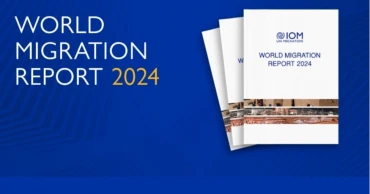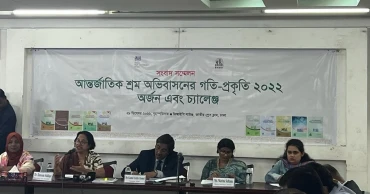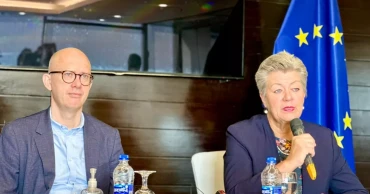Migration
The Human Face of International Migration: Stories, Struggles, and Statistics
International migration isn't just a global statistic; it's the raw pulse of human stories, sparked by fragile dreams of safety, prosperity, or family reunions, yet so often crushed under waves of heartbreak and hardship no one deserves.
As of mid-2024, the latest UN figures peg the global international migrant stock at 304 million people, about 3.7% of the world's population, each one shouldering a personal saga of bravery, grief, and quiet resilience.
These aren't faceless numbers; they're people like Ibtihal from Syria, who fled war in 2013 with her husband and five kids to Jordan, scraping by for over a decade before returning in 2025 to a ruined home that brought tears of joy and sorrow, as she whispered, "Life is truly painful." Or Harjit Singh from India's Punjab, who pawned family land for an $80,000 smuggling trek to the US, enduring jungles and detention only to be deported in debt, confessing, "I am broken inside… I don't see a future." And Maawia Alhassan from Sudan, a once-thriving shop owner who lost everything in 2023's conflict, fleeing alone to Uganda while agonizing over his missing wife and kids, holding on as he says, "The pain is immense, but I haven’t given up."
Read more: Challenges mount for Bangladesh as legal migration to Malaysia remains stalled
Top Countries Hosting and Sending International Migrants
You know how migration really works? It's not this neat little diagram; it's all over the place, with people heading out for decent work, dodging wars, coping with crazy climate stuff, or just holding onto family connections. The UN's newest numbers, fresh from their 2024 update that dropped in early 2025, have the total international migrants jumping from 275 million in 2020 up to 304 million by mid-2024, mostly because of big displacements and spots crying out for extra hands on deck.
Primary Host Nations: Havens Amid Strain
Host countries provide refuge and opportunity, but often at a cost to both newcomers and locals. The United States, home to over 52 million migrants, exemplifies this duality. Immigrants fuel innovation and growth, yet many, like undocumented farmworkers, toil in fields under harsh conditions, their contributions vital yet undervalued. Germany, with its welcoming policies, hosts millions fleeing conflict, but integration stories reveal struggles, such as language barriers that leave families feeling adrift.
Table: Here are the top 10 host countries, based on UN data for 2024.
Rank
Country
Migrant Stock (millions)
1
United States
52.4
2
Germany
16.8
3
Saudi Arabia
13.7
4
Russia
12.0
5
United Kingdom
9.6
6
United Arab Emirates
8.8
7
France
8.5
8
Canada
8.0
9
Australia
7.7
10
Italy
6.4
.
Read more: Essential services for Rohingyas at risk of collapsing; 150,000 more enter Bangladesh in 18 months: UNHCR
In Gulf states like the UAE, migrants from South Asia build skyscrapers but often face exploitative labor practices, their passports confiscated, binding them like modern-day indentured servants.
Leading Countries of Origin: Roots of Departure
Origin countries lose talent and youth, yet gain through remittances that sustain economies. India leads, with 18.5 million emigrants whose journeys are laced with sacrifice, think of Priya, a nurse in the UK, video-calling her children nightly, her heart torn between duty and longing.
The top 10 origin countries in 2024:
Rank
Country
Emigrants (millions)
1
India
18.5
2
Mexico
12.0
3
China
11.7
4
Russia
10.5
5
Syria
8.2
6
Philippines
6.5
7
Ukraine
6.0
8
Bangladesh
5.5
9
Pakistan
5.0
10
Afghanistan
4.8
Remittances reached $685 billion to low- and middle-income countries in 2024, often outpacing aid and investment, funding school fees and medical bills that keep families afloat.
Read more: Rohingyas are victims of racial discrimination and prolonged statelessness: Prof Yunus
5 months ago
Challenges mount for Bangladesh as legal migration to Malaysia remains stalled
Bangladesh is staring at a potential crisis as uncertainty looms over the future of its migrant workforce in Malaysia.
With legal migration routes facing significant hurdles, thousands of aspiring workers are at risk of turning to irregular and dangerous migration channels — a situation that could lead to economic setbacks and human rights violations.
Every year, tens of thousands of Bangladeshis seek employment abroad. Malaysia being one of the most favored destinations due to its labor demands and relatively stable wages.
Remittances from these migrant workers constitute one of the country's largest sources of foreign currency, significantly bolstering the national economy.
However, if the pathway for legal migration remains obstructed, the consequences could be far-reaching.
“Without legal channels, many desperate workers will contact to brokers who will promise them to sent abroad for jobs through student or tourist visas, which will only increase the risks of exploitation and abuse,” said a migration expert requesting anonymity.
He said that irregular migration routes expose workers to life-threatening journeys, extortion, trafficking, and even death. Once reach at abroad, they become undocumented migrants resulting they often live in fear of arrest and deportation. For it, they have to lead to mental health problems, social isolation, and a life of constant instability, he added.
Moreover, families who invest heavily in their loved ones’ migration sometimes taking loans or selling property, they fall in serious trouble failing of repay the money.
“Many end up paying exorbitant sums to middlemen, leaving them in deep debt even before they find employment,” said a Dhaka-based labour recruiter.
There is also an international dimension to the crisis. A surge in human smuggling and trafficking cases could damage Bangladesh’s reputation on the global stage, he said on condition not to disclose his identity.
K.M. Mobarak Ullah (Shimul), proprietor of Adeb Air Travels & Tours, said that general members of BAIRA are united in one demand--the immediate reopening of the labor market under any conditions.
“We are ready to comply with all the requirements set by the labor-receiving countries. Only the cronies of fascism are trying to impose unnecessary conditions on the labor market,” he claimed, " he added.
Experts warned that the country risks being downgraded in the U.S. State Department’s Trafficking in Persons (TIP) Report — a move that could strain bilateral relations and development aid.
Economically, the stakes are high. The loss of remittances from Malaysia, a key destination for Bangladeshi workers, could significantly weaken the country’s foreign exchange reserves. Already, concerns are growing that illegal channels might lead to an increase in unregistered remittances through informal “hundi” systems, further impacting national reserves and financial transparency.
HC asks to submit progress report of refunding money of 17,777 Malaysia returnees
The government, already under pressure to address rising economic hardship at home, could face additional financial burdens. “Support for deported migrants, repatriation of dead bodies, and psychological care for distressed workers abroad could add unexpected costs,” said an official from the Ministry of Expatriates’ Welfare and Overseas Employment.
In light of these looming threats, experts and rights groups are urging the government to act decisively, he added.
When his attention was drawn to the uncertainty over sending manpower in Malaysia, another senior officer of Expatriates Welfare and Overseas Employment Ministry said that it need to pave the way for legal, ethical migration with zero tolerance for corruption in the manpower sector. “A strong mandate must be enforced so that recruitment agencies strictly follow government rules,” he said requesting anonymity.
When he was asked although the government negotiates with Malaysian authorities and other labor-receiving countries, the fate of thousands of hopeful workers and the economic stability of Bangladesh hangs in the balance.
For it, he replied that amid swirling speculation, propaganda, and political finger-pointing, the long-awaited gateway to Malaysia is finally set to reopen for Bangladeshi migrant workers.
He said for the tireless efforts and diplomatic acumen of Advisor Asif Nazrul, the Malaysian government has finalised the date for the next Joint Working Group (JWG) meeting, scheduled for the second week of May in Putrajaya.
The move marks a significant breakthrough in the long-stalled labour migration process between the two nations and is expected to restore hope for thousands of aspiring migrant workers, he added.
8 months ago
Migrant remittances now outpace foreign investments in developing countries: IOM report
International migration remains a driver of human development and economic growth, highlighted by a more than 650 percent increase in international remittances from 2000 to 2022, rising from USD 128 billion to USD 831 billion, according to a new global report released today.
The growth continued despite predictions from many analysts that remittances would decrease substantially because of COVID-19.
The International Organization for Migration (IOM) launched the World Migration Report 2024, which reveals significant shifts in global migration patterns, including a record number of displaced people and a major increase in international remittances.
IOM Director General Amy Pope formally released the report in Bangladesh, which stands at the "forefront of migration" challenges, including emigration, immigration and displacement.
"We hope the report inspires collaborative efforts to harness the potential of migration as a driver for human development and global prosperity," DG Pope said.
By choosing Dhaka as the report's launch site, IOM not only highlights the country's efforts in supporting vulnerable migrants and fostering pathways for regular migration but also recognizes Bangladesh's important role in shaping global migration discourse and policy, IOM said.
As a Global Compact for Safe, Orderly, and Regular Migration Champion country, Bangladesh has demonstrated a strong commitment to addressing migration issues and implementing policies that safeguard migrants' rights, it said.
Read more: Global actors pledge to collaborate on transformation of Bangladesh agriculture
This proactive engagement aligns with IOM's strategic objectives, making Bangladesh an ideal location to launch the 2024 World Migration Report.
Foreign Minister Dr Hasan Mahmud said as one of the GCM champion countries, Bangladesh will not only continue to act upon the pledges it has made for its domestic context but would also take up emerging issues and challenges pertaining to migration and development for informed deliberations at the international level.
“The World Migration Report 2024 helps demystify the complexity of human mobility through evidence-based data and analysis,” Pope said at the launch.
“In a world grappling with uncertainty, understanding migration dynamics is essential for informed decision-making and effective policy responses, and the World Migration Report advances this understanding by shedding light on longstanding trends and emerging challenges.”
Of that 831 billion in remittances, 647 billion were sent by migrants to low and middle-income countries. These remittances can constitute a significant portion of those countries' GDPs, and globally, these remittances now surpass foreign direct investment in those countries.
Highlighting key findings, the report reveals that while international migration continues to drive human development, challenges persist.
Read more: UK Minister for Indo-Pacific arrives Tuesday on two-day visit
With an estimated 281 million international migrants worldwide, the number of displaced individuals due to conflict, violence, disaster, and other reasons has surged to the highest levels in modern-day records, reaching 117 million, underscoring the urgency of addressing displacement crises.
Migration, an intrinsic part of human history, is often overshadowed by sensationalized narratives.
However, the reality is far more nuanced than what captures headlines.
Most migration is regular, safe, and regionally focused, directly linked to opportunities and livelihoods.
Yet, misinformation and politicization have clouded public discourse, necessitating a clear and accurate portrayal of migration dynamics.
IOM’s World Migration Report, with its innovative digital tools and comprehensive analysis, aims to help dispel myths, provide critical insights, and inspire meaningful action in addressing the challenges and opportunities of human mobility.
This launch is part of IOM Director General’s first three-day visit to Bangladesh.
Chief of IOM Mission in Bangladesh Abdusattor Esoev, former Foreign Secretary Shahidul Haque, senior government officials and diplomats stationed in Dhaka were present at the report launching ceremony.
Read more: UK Minister for Indo-Pacific in Dhaka to ‘strengthen’ economic, security, migration partnership with Bangladesh
1 year ago
PM to visit Rome later this month to attend UN Food Systems Summit; bilateral deals on energy, migration likely
Prime Minister Sheikh Hasina is scheduled to visit Rome, Italy later this month to discuss bilateral issues and attend the UN Food Systems Summit.
The 2023 UN Food Systems Stocktaking Moment will be held in Rome, Italy on July 24-26 at the premises of the Food and Agriculture Organization of the United Nations (FAO).
It will be hosted by Italy in collaboration with the Rome-based UN Agencies (FAO, IFAD, WFP), the UN Food Systems Coordination Hub, and the wider UN system.
The Prime Minister is scheduled to be in Rome from July 23, said a diplomatic source.
Also read: PM Hasina to visit Japan on April 25-28
She is likely to have a bilateral meeting with her Italian counterpart Giorgia Meloni during the visit.
PM Hasina will speak at the Food System Summit in Rome while her Italy visit is likely to see the signing of half a dozen bilateral documents in the areas of energy, migration, ICT and cyber security.
Bangladesh and Italy have been discussing a possible memorandum of understanding (MoU ) on mobility and migration — to encourage regular migration and prevent irregular ones.
“We want to go further in our cooperation on migration issues. In particular, creating and enlarging the existing legal channels or legal pathways for migration while stemming the irregular one,”
Italian Ambassador to Bangladesh Enrico Nunziata told UNB in an interview recently.
Also read: PM leaves Geneva for home ending 3-day visit
The envoy said the two countries have to deepen cooperation for preventing irregular migration, trafficking and so on.
Ambassador Nunziata recalled one of the deliverables during Prime Minister Sheikh Hasina’s visit to Italy in 2020 — reinsertion of Bangladesh in the list of countries whose nationals can benefit from a quota for work.
Talking about collaboration in the defence sector, he said there is possibility of collaboration and transfer of know-how as well on a win-win basis. “So this is another important sector.”
The ambassador said a memorandum of understanding in the cultural sphere for programmes of cultural exchanges is also in the pipeline.
Also read: PM to brief media on the outcome of her Switzerland visit on Wednesday
The Italian ambassador also said they want to collaborate in the shipbuilding industry for the Navy or Coast Guard by sharing know-how and technologies with Bangladesh. “I mean that level of know-how that Bangladesh has not reached in shipbuilding yet. Together we can do more on that in shipbuilding as well as in other sectors.”
The 2023 UN Food Systems Stocktaking Moment will build on the momentum of the 2021 Food Systems Summit and will create a conducive space for countries to review commitments to action that were made during the Summit, share stories of success and early signs of transformation, maintain the momentum for bold acceleration and bold action to further the resilience of food systems, advocate for their adaptation to climate change, ensure they contribute to communities’ resilience to further shocks and crises, and boost the achievement of the Sustainable Development Goals (SDGs).
Read more: PM Hasina leaves for Geneva to attend World of Work Summit
2 years ago
Italy: Migrants paid 8,000 euros each for ‘voyage of death’
Rescue teams pulled more bodies from the sea on Tuesday, bringing the death toll from Italy’s latest migration tragedy to 65, as prosecutors identified suspected smugglers who allegedly charged 8,000 euros (nearly $8,500) for each person making the “voyage of death” from Turkey to Italy.
Authorities delayed a planned viewing of the coffins to allow more time for identification of the bodies, as desperate relatives and friends arrived in the Calabrian city of Crotone in hope of finding their loved ones, some of whom hailed from Afghanistan.
“I am looking for my aunt and her three children,” said Aladdin Mohibzada, adding that he drove 25 hours from Germany to reach the makeshift morgue set up at a sports stadium. He said he had ascertained that his aunt and two of the children died, but that a 5-year-old survived and was being sheltered in a center for minors.
Also Read: Deadly shipwreck in Italy must trigger action to save lives: UN
“We are looking into possibilities to send (the bodies) to Afghanistan, the bodies that are here,” he told The Associated Press outside the morgue. But he complained about a lack of information as authorities scrambled to cope with the disaster. “We are helpless here. We don’t know what we should do.”
At least 65 people, including 14 minors, died when their overcrowded wooden boat slammed into shoals 100 meters (yards) off the shore of Cutro and broke apart early Sunday in rough seas. Eighty people survived, but many more are feared dead since survivors indicated the boat had carried about 170 people when it set off last week from Izmir, Turkey.
Aid groups at the scene have said many of the passengers hailed from Afghanistan, including entire families, as well as from Pakistan, Syria and Iraq. Rescue teams pulled two bodies from the sea on Tuesday, bringing the toll to 65, police said.
Also Read: Rescuers find 60th body off Italy after migrant shipwreck
Premier Giorgia Meloni sent a letter to European leaders demanding quick action on the continent’s longstanding migration problem, insisting that migrants must be stopped from risking their lives on dangerous sea crossings.
“The point is, the more people who set off, the more people risk dying,” she told RAI state television late Monday.
Meloni’s right-wing government, which swept elections last year in part on promises to crack down on migration, has concentrated on complicating efforts by humanitarian boats to make multiple rescues in the central Mediterranean by assigning them ports of disembarkation along Italy’s northern coasts. That means the vessels need more time to return to sea after bringing migrants aboard and taking them safely to shore.
But aid groups’ rescue ships don’t normally operate in the area of Sunday’s shipwreck, which occurred off the Calabrian coast in the Ionian Sea. Rather, the aid groups generally operate in the central Mediterranean, rescuing migrants who set off from Libya or Tunisia — not from Turkey in the eastern Mediterranean.
Crotone prosecutor Giuseppe Capoccia confirmed investigators had identified three suspected smugglers, a Turk and two Pakistani nationals. A second Turk is believed to have escaped or died in the wreck.
Italy’s border police said in a statement that organizers of the crossing charged 8,000 euros (around $8,500) each for the “voyage of death.”
Interior Minister Matteo Piantedosi pushed back at suggestions that the rescue was delayed or affected by government policy discouraging aid groups from staying at sea to rescue migrants.
The EU border agency Frontex has said its aircraft spotted the boat off Crotone at 10:26 p.m. Saturday and alerted Italian authorities. Italy sent out two patrol vessels, but they had to turn back because of the poor weather.
Piantedosi told a parliamentary committee that the ship ran aground and broke apart at around 5 a.m. Sunday.
“There was no delay,” Piantedosi told Corriere della Sera. “Everything possible was done in absolutely prohibitive sea conditions.”
The Italian Coast Guard issued a statement on Tuesday saying Frontex had indicated that the migrants’ boat was “navigating normally” and that only one person could be seen above deck.
It added that an Italian border police vessel, “already operating in the sea” set out to intercept the migrant boat.
“At about 4:30 a.m., some indications by telephone from subjects on land, relative to a boat in danger a few meters from the coast, reached the Coast Guard,″ the statement said.
At that point, a Carabinieri police boat which had been alerted by border police “informed the Coast Guard about the shipwreck.”
In contrast to similar cases of migrant vessels in distress, “no phone indication ever came from migrants aboard” to the Coast Guard, the statement noted.
Not rarely, migrants aboard a vessel in distress contact Alarm Phone, a humanitarian support hotline which relays indications of boats in trouble in the Mediterranean to maritime authorities.
When briefing lawmakers, the interior minister cited figures supporting Italy’s long-held frustration that fellow European Union nations don’t honor pledges to accept a share of asylum-seeking migrants who reach Italy.
Piantedosi said that while these pledges covered some 8,000 migrant relocations from June last year through this month, only 387 people actually were transferred to other EU nations, with Germany taking in most of them.
2 years ago
2022 may show 3.17% fall in remittance receipts: RMMRU
The year 2022 may show a 3.17 percent drop in remittance inflow to Bangladesh compared to 2021, a Refugee and Migratory Movements Research Unit (RMMRU) report revealed Thursday said.
The migrant workers sent $19.58 billion home during January-November of 2022. If this trend continues, the remittance income will stand at $21.36 billion at the end of the year, it added.
The report also assumed that the country's overseas employment will rise by 81.88 percent this year. Bangladesh sent more than 1.0 million workers abroad in the first 11 months of this year.
Employment will stand at more than 1.1 million at the end of the year, it added.
The report "Labour Migration from Bangladesh 2022: Achievements and Challenges" was disclosed in Dhaka.
RMMRU Chair Professor Tasneem Siddiqui, who presented the report, said: "Declining growth in remittance inflow depends on various factors. Workers are heavily dependent on hundi due to low rates in banks."
"Also, workers usually cannot send remittances in the first year of their migration. Every year a significant number of workers are cheated while going abroad, and they do not get the right jobs. Moreover, many of them arrange money from home to return."
The RMMRU chair suggested ensuring safe migration and increasing incentives for the workers to encourage them to send money through official channels.
"The incentive should be 10 percent for the remitters," she said. "If the apparel makers receive attractive cash incentive support, then why not migrant workers?"
The report showed that the skilled worker migration decreased in 2022 compared to the previous year. As of December 21, this year, of the total outbound workers, 17.76 percent were skilled workers; 21.33 percent of skilled workers went abroad in 2021.
Read more: Swift return of irregular migrants to help promote legal migration: European Commissioner
Among the outbound Bangladeshis, the number of professionals is lower. However, it slightly increased compared to last year.
As of December 21, this year about 0.33 percent of professionals out of the total migrants went abroad with jobs. The number of professionals was 0.14 percent in 2021, the report said.
Some 99,684 women went abroad with jobs during January-November this year.
If the trend of outflow continues, the migration of women will increase by nearly 35 percent in 2022 compared to the previous year, the report said.
Quoting the US-based Trafficking in Persons report 2022, RMMRU said while the migration cost has decreased slightly, it is still the highest in South Asia for Bangladeshi migrants.
It also said although the opening of the Malaysian market was a major development in the outgoing year, workers are still suffering from unethical migration costs. "A section of recruiters continue this unethical practice."
Read more: US Asst Secretary Noyes in Bangladesh to discuss refugee, migration issues
3 years ago
US border cities strained ahead of expected migrant surge
Along the U.S. southern border, two cities — El Paso, Texas, and Ciudad Juarez in Mexico — prepared Sunday for a surge of as many as 5,000 new migrants a day as pandemic-era immigration restrictions expire this week, setting in motion plans for emergency housing, food and other essentials.
On the Mexican side of the international border, only heaps of discarded clothes, shoes and backpacks remained Sunday morning on the banks of the Rio Grande River, where until a couple of days ago hundreds of people were lining up to turn themselves in to U.S. officials. One young man from Ecuador stood uncertain on the Mexican side; he asked two journalists if they knew anything about what would happen if he turned himself in without having a sponsor in the U.S., and then gingerly removed sneakers and socks and hopped across the low water.
On the American side, by a small fence guarded by several Border Patrol vehicles, he joined a line of a dozen people who stood waiting with no U.S. officials in sight.
El Paso County Judge Ricardo Samaniego told The Associated Press on Sunday that the region, home to one of the busiest border crossings in the country, was coordinating housing and relocation efforts with groups and other cities, as well as calling on the state and federal government for humanitarian help. The area is preparing for an onslaught of new arrivals that could double their daily numbers once public health rule Title 42 ends on Wednesday.
The rule has been used to deter more than 2.5 million migrants from crossing since March 2020.
At a migrant shelter not far from the river in a poor Ciudad Juárez neighborhood, Carmen Aros, 31, knew little about U.S. policies. In fact, she said she’d heard the border might close on Dec. 21.
She fled the cartel violence in the Mexican state of Zacatecas a month ago, right after her fifth daughter was born and her husband went missing. The Methodist pastor who runs the Buen Samaritano shelter put her on a list to be paroled into the United States and she waits every week to be called.
“They told me there was asylum in Juarez, but in truth, I didn’t know much,” she said on the bunk bed she shared with the girls. “We got here … and now let’s see if the government of the United States can resolve our case.”
At a vast shelter run by the Mexican government in a former Ciudad Juárez factory, dozens of migrants watched the World Cup final Sunday on two TVs while a visiting team of doctors from El Paso treated many who had come down with respiratory illness in the cold weather.
Read: ‘Over 51,000 migrants die, thousands go missing in 8 years’
Constantly changing policies make it hard to plan, said Dylan Corbett, director of the Hope Border Institute, a Catholic organization helping migrants in both El Paso and Juarez. The group started the clinic two months ago.
“You have a lot of pent-up pain,” Corbett said. “I’m afraid of what’s going to happen.” With government policies in disarray, “the majority of the work falls to faith communities to pick up the pieces and deal with the consequences.”
Just a couple blocks across the border, sleet fell in El Paso as about 80 huddled migrants ate tacos that volunteers grilled up. Temperatures in the region were set to drop below freezing this week.
“We’re going to keep giving them as much as we have,” said Veronica Castorena, who came out with her husband with tortillas and ground beef as well as blankets for those who will likely sleep on the streets.
Jeff Petion, the owner of a trucking school in town, said this was his second time coming with employees to help migrants in the streets. “They’re out here, they’re cold, they’re hungry, so we wanted to let them know they’re not alone.
But across the street from Petion, Kathy Countiss, a retiree, said she worries the new arrivals will get out of control in El Paso, draining resources and directing enforcement away from criminals to those claiming asylum.
On Saturday, El Paso Mayor Oscar Leeser issued an emergency declaration to access additional local and state resources for building shelters and other urgently needed aid.
Samaniego, the county judge, said the order came one day after El Paso officials sent Texas Gov. Greg Abbott a letter requesting humanitarian assistance for the region, adding that the request was for resources to help tend to and relocate the newly arriving migrants, not additional security forces.
Samaniego said he has received no response to the request and plans to issue a similar county-wide emergency declaration specifying the kind of help the area needs if the city does not get state aid soon. He urged the state and federal governments to provide the additional money, adding they had a strategy in place but were short in financial, essential and volunteer resources.
El Paso officials have been coordinating with organizations to provide temporary housing for migrants while they are processed and given sponsors and relocate them to bigger cities where they can be flown or bused to their final destinations, Samaniego said. As of Wednesday, they will all join forces at a one-stop emergency command center, Samaniego said, similarly to their approach to the COVID-19 emergency.
Abbott, El Paso city officials and U.S. Customs and Border Protection did not immediately respond to requests for comment on Sunday.
Read: Swift return of irregular migrants to help promote legal migration: European Commissioner
Abbott has committed billions of dollars to “Operation Lone Star,” an unprecedented border security effort that has included busing migrants to so-called sanctuary cities like New York, Los Angeles and Washington, D.C., as well as a massive presence of state troopers and National Guard along the Texas-Mexico border.
Additionally, the Republican Texas governor has pushed continued efforts to build former President Donald Trump’s wall using mostly private land along the border and crowdsourcing funds to help pay for it.
El Paso was the fifth-busiest of the Border Patrol’s nine sectors along the Mexico border as recently as March and suddenly became the most popular by far in October, jumping ahead of Del Rio, Texas, which itself had replaced Texas’ Rio Grande Valley as the busiest corridor at lightning-speed late last year. It is unclear why El Paso has become such a powerful magnet in recent months, drawing especially high numbers of migrants since September.
Recent illegal crossings in El Paso – at first largely dominated by Venezuelans and more recently by Nicaraguans – are reminiscent of a short period in 2019, when the westernmost reaches of Texas and eastern end of New Mexico were quickly overwhelmed with new arrivals from Cuba and Central America. El Paso had been a relatively sleepy area for illegal crossings for years.
Meanwhile, a group of about 300 migrants began walking northward Saturday night from an area near the Mexico-Guatemala border before being stopped by Mexican authorities. Some wanted to arrive on Dec. 21, under the mistaken belief that the end of the measure would men they could no longer request asylum. Misinformation about U.S. immigration rules is often rife among migrants. The group was largely made up of Central Americans and Venezuelans who had crossed the southern border into Mexico and had waited in vain for transit or exit visas, migratory forms that might have allowed them to make it across Mexico to the U.S. border.
“We want to get to the United States as soon as possible, before they close the border, that’s what we’re worried about,” said Venezuelan migrant Erick Martínez.
3 years ago
Over 280m people leave home for a better life: UN
More than 280 million people have left their countries to pursue opportunity, dignity, freedom, and a better life, the UN said on International Migrants Day Sunday.
Secretary-General António Guterres credited more than 80 percent of those who cross borders in a safe and orderly fashion as powerful drivers of economic growth, dynamism, and understanding.
"But unregulated migration along increasingly perilous routes – the cruel realm of traffickers – continues to extract a terrible cost."
Over the past eight years, at least 51,000 migrants have died, and thousands of others have gone missing, said the top UN official.
"Behind each number is a human being – a sister, brother, daughter, son, mother, or father," he said. "Migrant rights are human rights."
Read: US Asst Secretary Noyes in Bangladesh to discuss refugee, migration issues
"They must be respected without discrimination – and irrespective of whether their movement is forced, voluntary, or formally authorised."
Guterres pushed for search and rescue efforts, medical care, expanded and diversified rights-based pathways for migration, and greater international investments in countries of origin to ensure migration is a choice, not a necessity.
Gilbert F Houngbo, the head of the International Labour Organization (ILO), shone a light on protecting the rights of the world's 169 million migrant workers.
"The international community must do better to ensure… [that they] are able to realise their basic human and labour rights."
Leaving them unable to exercise basic rights renders migrant workers invisible, vulnerable and undervalued for their contributions to society, said the most senior ILO official.
And when intersecting with race, ethnicity, and gender, they become even more vulnerable to various forms of discrimination.
Houngbo said migrants do not only go missing on high-risk and desperate journeys. "Many migrant domestic, agricultural and other workers are isolated and out of reach of those who could protect them, with the undocumented, particularly at risk of abuse."
Read: COP27: FM calls for collective action to mainstream climate-induced migration in negotiations
Like all employees, migrant workers are entitled to labour standards and international human rights protections, including freedom of association and collective bargaining, non-discrimination, and safe and healthy working environments, said the ILO chief.
They should also be entitled to social protection, development and recognition, he added.
To make these rights a reality, Houngbo stressed the key importance of fair recruitment, including eliminating recruitment fees charged to migrant workers, which can help eradicate human trafficking and forced labour.
3 years ago
Swift return of irregular migrants to help promote legal migration: European Commissioner
European Commissioner for Home Affairs Ylva Johansson has said sending the irregular migrants back to the country of origin swiftly from the European countries will help manage migration safely together moving away from irregular to regular.
“It is important that those who arrive irregularly should be sent back swiftly to the country of origin - Bangladesh - to really show that this is not the way to come to the European countries,” she told UNB while responding to a question.
EU Ambassador to Bangladesh Charles Whiteley accompanied the European Commissioner during the interview here on Friday.
Also read: FM Momen urges Japan to stand by Bangladesh in its development journey
Johansson, also a former Minister for Employment and Integration of Sweden, said the cooperation on return has really increased and deepened in recent times with immediate reaction as the member states now say they are ready to open for more labour migration and more legal pathways.
She said it is important to say that irregular migration cannot be stopped fully without making better opportunities through legal ways.
The European Commissioner said there are many things they can do together including efforts to give the right information to the people about the risk of irregular arrivals in Europe.
3 years ago
Migration trends at New York Fashion Week
The New York Fashion Week, one of the most prestigious fashion events of the year, became a celebration of diversity and inclusion earlier last month when designers backed by the No Nation Fashion initiative showcased their creations on the catwalk.
The three outfits presented by No Nation Fashion at the event were designed to reflect the journey of migrants – from the earliest nomad way of life to resilience and the ability to rebuild and adapt, and inclusion through social and cultural integration at their destinations.
Read: Spray-painted on the body: Bella Hadid’s Paris Fashion Week dress breaks internet
Launched as a way for people in transit centres to improve their sewing skills in Bosnia and Herzegovina in 2021, No Nation Fashion has come a long way, according to UN News.
Those involved graduated from creating reusable masks, providing protection against Covid-19, to designing unique items of clothing, and accessories.
3 years ago



















